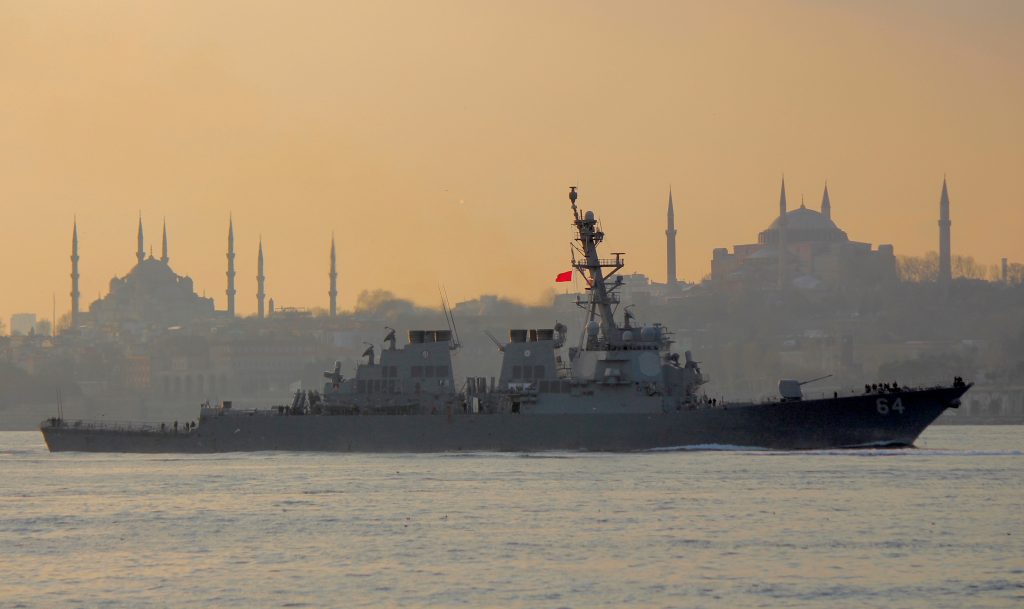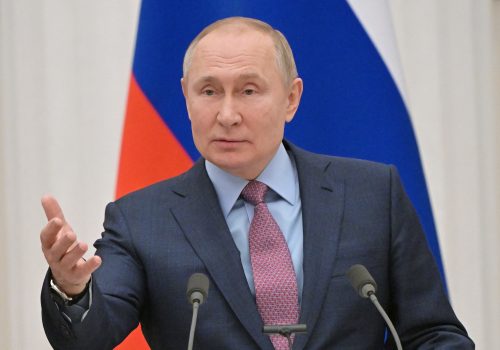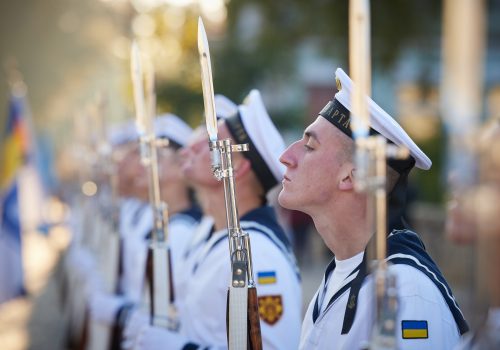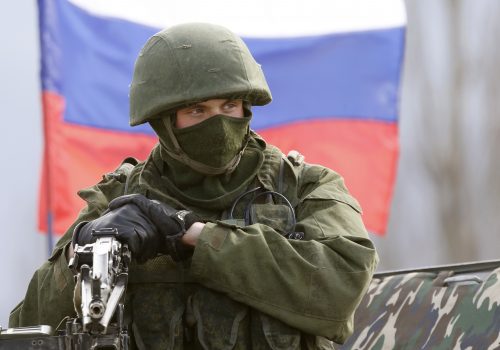How quickly tectonic change occurs. The first draft of this paper was written in October 2021 and aimed at convincing NATO of the need to focus more heavily on the Black Sea region. The reason for this major shift was the importance of the Black Sea region to Russia as its strategic center of gravity. Then came the Ukraine crisis.
Still, the risk remains that once this crisis ends, NATO may continue to neglect the Black Sea as it has consistently done well after its membership expanded in the region in 2004. Of course, how this crisis evolves will certainly determine what NATO should do, though not necessarily what it will do, regarding the Black Sea.
Before returning to the implications of the Ukraine crisis, a bit of history and geography is useful for those not familiar with the region. The Black Sea region encompasses the Balkans, stretching east beyond the Caspian to Eurasia, and is the gateway to the Mediterranean, Africa, Eurasia and the Near East.
Dating back to the Cold War, the Central Front and Fulda Gap, the Baltics, and the High North have been NATO’s traditional centers of gravity and principal focus. The Russian occupation of Georgia’s South Ossetia in 2008 followed by Crimea and parts of eastern Ukraine in 2014 reawakened the alliance to the Black Sea region’s importance. However, unlike the steps taken to reinforce deterrence and reassurance in NATO’s center and the Baltics, similar actions were not repeated in the Black Sea to the same level.
Freedom of navigation exercises were increased while being limited by the Montreux Convention. US strategic bombers made cameo appearances. Aegis ashore had been deployed to Romania as a counter to potential Iranian ballistic missiles, not Russian, that so far have yet to appear. More military exercises and air policing exercises were scheduled and conducted. NATO’s Allied Joint Force Command Naples became more engaged and two NATO commands were established in Romania. But the proposition of how the Black Sea region might be strategically exploited lay moribund and unaddressed.
Has the Ukraine crisis provided the rationale to change this opportunity? Or is it too late as some of NATO’s thirty members may not wish to provoke Russia any further, especially if the region is as important to Moscow as is argued?
Three questions frame the answers.
Firstly, how strategically important is the Black Sea region to Russia, especially in light of Ukraine, and hence to NATO? In terms of priorities, is Russian President Vladimir Putin’s objective of imposing a strategic framework in Europe based on pre-1997 conditions more important?
Secondly, if the region is of such importance to Russia, will any more evidence be needed to change minds in NATO to adjust strategic priorities so that the Black Sea is of equivalent importance to other regions? Or would resolution of the current crisis lead NATO to lowering its presence and engagement in the Black Sea region as part of an agreement?
Thirdly, given these answers, what are the overall aims and objectives of a possible NATO Black Sea Region Strategy and what tactical, operational, strategic, and political actions should follow in light of the situation around Ukraine to implement this plan?
The Black Sea region had been of lower priority to NATO for clear and understandable reasons. Surprisingly, unlike the Cold War and the prominence of the inner-German border with the USSR and Warsaw Pact, today only four of thirty NATO member states border directly on Russia (the list includes two more members if Kaliningrad, the Russian enclave in the Baltic, is included). These NATO members are Estonia and Latvia in the Baltic, Norway in the high north, and the United States in Alaskan waters. Canada is close. Geographic proximity has traditionally produced a certain sensitivity and vulnerability to potential Russian aggression.
Stay updated
As the world watches the Russian invasion of Ukraine unfold, UkraineAlert delivers the best Atlantic Council expert insight and analysis on Ukraine twice a week directly to your inbox.
The majority of major NATO states are located in the center, Baltics and north or nearby, particularly those with larger armies such as Britain, Poland, France and Germany. During the Trump administration, the notion of a Russian fait accompli, mainly the seizure of the three Baltic states, gained prominence and became the raison d’être for deploying forces to underscore the region’s strategic relevance to NATO and to reinforce deterrence.
Unlike northern Europe with its mature and plentiful bases, Black Sea access is more difficult. The Bosphorus and Dardanelles are the only sea passages from the Mediterranean. The Montreux Convention limits the presence of warships in terms of armaments, tonnage, numbers, and duration as well as preventing access to submarines from non-Black Sea nations. Meanwhile, the Russian Northern Fleet is far more powerful than the Black Sea Fleet and serves as the home port for Russian ballistic missile nuclear submarines.
Land logistics through the Balkans are austere at best. There are fewer bases and infrastructure present. Of the three NATO members situated in the Black Sea, Turkey is irascible; Bulgaria until recently suffered from Russian influence; and Romania just survived its most serious political crisis since 1989. The latter two are relatively small in population and joined NATO in 2004, well after the Cold War ended.
For NATO and the US, during the Cold War and well beyond, the center of gravity remained what was called the central front and the north. Indeed, Russia has no intention of risking a war with NATO over the Baltic states. NATO’s Article 5 mandates an attack against one will be considered an attack against all. While not ironclad, this ensures the safety and security of the Baltic states.
Before 2014 and the seizure of Crimea, Article 5 was viewed as having similar relevance for the Black Sea and was a further reason for not viewing the region as a strategic opportunity. After all, if Russia were to attack the three NATO states in the Black Sea, a land invasion must transit through Ukraine at huge cost in casualties to reach Romania, or by sea and air to move against Bulgaria, Romania and Turkey. This would require capabilities Russia does not and will not have for some time, although the crisis in Ukraine can obviously change that calculus.
Russia maintains what was a modest Black Sea Fleet stationed in Sevastopol in Crimea along with more formidable land, air, and defense forces in the region that assumed greater significance following Russia’s 2008 occupation of Georgia’s South Ossetia, the 2014 annexation of Crimea, and deployment of its forces in the Donbas and eastern Ukraine where conflict still persists. In response, NATO gradually increased its presence and freedom of navigation missions in the Black Sea.
Russia has now massed well over 100,000 troops on Ukraine’s borders and sent 30,000 troops on exercises in Belarus that are set to end on February 20. Six Russian Navy landing ships and one Kilo class diesel submarine have reinforced the Black Sea Fleet. The landing ships could carry up to 2000 troops and about sixty tracked vehicles.
Why is the Black Sea region so important to Russia? Moscow sees the criticality of Ukraine and to a lesser degree Georgia in protecting Russia’s underbelly from Western influence and NATO expansion as well as the growing Islamist threat.
Ukraine was integral and once the heart of Russia and part of its cultural heritage. Kyiv is regarded by Russians as the “mother city” of their entire civilization. While Nikita Khrushchev was not technically born in Ukraine, he regarded it as his home and much of his civilian career in World War II was spent there (Stalin, by the way was Georgian). Putin’s 5000-word missive published last July made the case that Russians and Ukrainians are one people.
If Russia launches a major offensive against Ukraine as President Biden is predicting, NATO’s response will make what actions the alliance took after Russia’s 2014 Crimean annexation appear anemic. NATO will expand its military capability and the size of its forces stationed in Europe, exactly the opposite of Putin’s intent. More advanced weapons will be developed and deployed, including new classes of nuclear tipped missiles with lower yield warheads.
Sanctions will be imposed more strictly and robustly than before. How much this will dent Russia’s economy or Putin’s inner circle is uncertain. However, the Nord Stream 2 pipeline will almost certainly be canceled, hitting Russia’s energy sector. Whatever credibility Putin may have gained will be lost given the “big lie” of his assurances that force would not be used in Ukraine.
Of course, Russia will have invented the excuse of accusing the West of provoking violence and aggression requiring an “appropriate response.” But regardless of whether Russian force is used or not, NATO would be wise and prudent to develop a Black Sea Strategy for any contingency. Logic would suggest NATO should need no further rationale to act. Ukraine could be the 21st century version of the Fulda Gap.
Eurasia Center events

One further scenario reinforces the need for a NATO Black Sea Strategy: Russia could use a minimal amount of force with virtually no casualties to gain maximum political leverage via a takeover of Ukraine’s Serpent Island, which lies fifty kilometers east of the mouth of the Danube at the very western end of the Black Sea. Indeed this may be one of Putin’s ploys.
While the island is virtually uninhabited, how would Ukraine and NATO respond? The immediate threat would be to Romania and by extension Bulgaria. Even the Danube could be seen as vulnerable to further Russian intimidation especially as another member, Hungary with its Prime Minister Viktor Orban, looks favorably on Moscow.
This scenario and its consequences are examined in detail in my latest book “The Fifth Horseman and the New MAD—How Massive Attacks of Disruption Became the Looming Existential Danger to a Divided Nation and the World at Large.”
What must NATO do in the Black Sea no matter how the Ukraine crisis turns out? Clearly, NATO needs a Black Sea Strategy. The basis for this strategy must be preventing and defending against Russian initiatives and policies inimical to ours through strategic, military, economic and diplomatic means, while also engaging where possible.
The first action is to adopt a Porcupine Defense. The purpose of the Porcupine Defense is to impose such costs on any initial foray by Russia to make an attack too expensive through a strategy of disruption. That would enable time for NATO reinforcement and thus enhance deterrence.
Disruption would cover an enemy’s command, control, communications, logistics, movement, information and, in essence, the ability to wage war. Porcupine also exploits geography and topography. To move west, Russia would have to march through Ukraine, a scenario that is now more plausible. However, some estimates suggest more than 30,000 casualties would be imposed on the Russian Army by a very hostile Ukrainian population.
This is how Romania or Bulgaria could implement a Porcupine Defense. The defending force must be capable of imposing maximum disruption, hence pain and costs, in the shortest time on an attacking force. Tens of thousands of unmanned drones operating on land, on and under the sea, and in the air would envelop and attempt to overwhelm the enemy.
Since, for example, access roads into Romania are well-known, Porcupine Defense would include using 20,000 pound explosive devices to destroy and block those routes disrupting access. Deception, misdirection, misinformation, disinformation and the full range of information warfare would be directed against any attacking force along with kinetic anti-armor and anti-air shoulder fired missiles in vast numbers. A home guard or partisan force would be trained to harass the enemy through guerrilla tactics.
Given the topography, much of an enemy advance would be restricted to roads. Targeting the logistics and choke points would create huge roadblocks and traffic jams disrupting any invading force. And developing low orbit cheap satellites that can be quickly launched to replace command, control, communications and surveillance capabilities will be required.
Among the highest priorities, the Russian Black Sea Fleet must be put at risk at distance. For Romania and its Navy, Porcupine requires obtaining long range cruise missiles to threaten the Black Sea Fleet in its home waters; an array of unmanned ASW and ASUW sensors and weapons to complement this strategy; and even purchasing submarines under a program parallel to AUKUS (Australia-UK-US) in which Australia is planning to procure as many as a dozen nuclear submarines; and Over the Horizon (OTH) radars in aerostats/Lighter than Air (LTA) vehicles known as Blimps; EW deception, misinformation and disinformation systems; and other capabilities. Putting the Black Sea Fleet at risk must be the aim.
The port of Constanta on Romania’s east coast would be turned into a mini-Kaliningrad militarily and a Rotterdam-sized port economically. Anti-surface and anti-air systems would be reinforced by the nearby Mihail Kogalniceanu (MK) airbase, in the process of being upgraded to accommodate fifth generation aircraft. US and NATO aircraft would also deploy more to MK to bolster NATO capabilities.
Further, despite the recommendation below about amending the Montreux Convention, other means can circumvent it. The Danube Convention is one. Naval units assigned to the Danube are not subject to the limits imposed by Montreux. Hence, US small craft, possibly armed with Tomahawks or long range surface to surface missiles could operate in the Black Sea. Indeed, since the US Army has numerically more craft than the Navy has ships, Army and Marine participation should not be dismissed.
Economically, dredging the Danube to about four meters will double the throughput making Constanta the equivalent of Rotterdam adding to its potency as the pathway to the east through Georgia that likewise will attract Russian attention. The Three Seas Initiatives support this and provide NATO a better logistical avenue than the land routes across the Balkans that are austere at best.
Diplomatically, modifying the Montreux Convention to account for reality can be pursued. The Soviet Union, one of the 1936 signatories, no longer exists; Georgia and Ukraine are new states who were not signatories to the original treaty. Turkey will strongly oppose any modifications. But options exist such as re-flagging warships to Romania, still under US command. As noted, another option is stationing forces in the Danube Delta that can operate with no restrictions on entering the Black Sea.
A Black Sea Region Strategy may not be a perfect cure or solution for NATO. But without closer examination of options, it will be a massively missed opportunity. This issue has been made more urgent by the Ukraine crisis. If we are not already thinking about the next steps for NATO after this crisis, then shame on us!
Dr. Harlan Ullman is Senior Advisor at the Atlantic Council and the prime author of “Shock and Awe.” From 2016-2019, he was a Distinguished Visiting Professor and Distinguished Senior Fellow at the US Naval War College. His latest book is “The Fifth Horseman and the New MAD: How Massive Attacks of Disruption Became the Looming Existential Danger to a Divided Nation and the World at Large.”
Further reading
The views expressed in UkraineAlert are solely those of the authors and do not necessarily reflect the views of the Atlantic Council, its staff, or its supporters.

The Eurasia Center’s mission is to enhance transatlantic cooperation in promoting stability, democratic values and prosperity in Eurasia, from Eastern Europe and Turkey in the West to the Caucasus, Russia and Central Asia in the East.
Follow us on social media
and support our work
Image: The US Navy destroyer USS Carney sets sail in the Bosphorus, on its way to the Black Sea. January 5, 2018. (REUTERS/Yoruk Isik)




